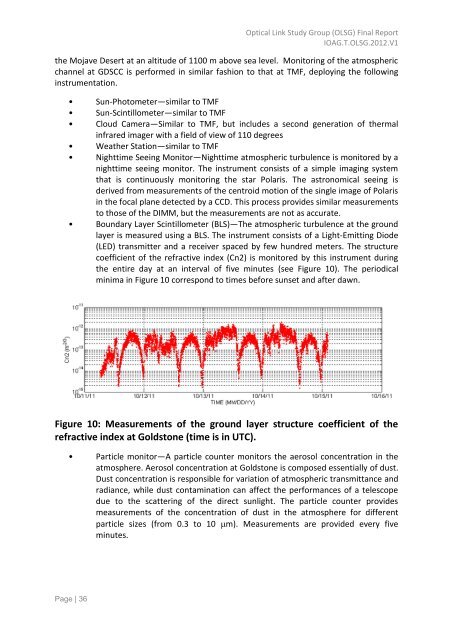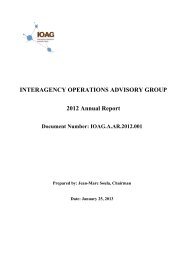OLSG Report_Final_06_05_12 - Interagency Operations Advisory ...
OLSG Report_Final_06_05_12 - Interagency Operations Advisory ...
OLSG Report_Final_06_05_12 - Interagency Operations Advisory ...
You also want an ePaper? Increase the reach of your titles
YUMPU automatically turns print PDFs into web optimized ePapers that Google loves.
Optical Link Study Group (<strong>OLSG</strong>) <strong>Final</strong> <strong>Report</strong><br />
IOAG.T.<strong>OLSG</strong>.20<strong>12</strong>.V1<br />
the Mojave Desert at an altitude of 1100 m above sea level. Monitoring of the atmospheric<br />
channel at GDSCC is performed in similar fashion to that at TMF, deploying the following<br />
instrumentation.<br />
• Sun-Photometer—similar to TMF<br />
• Sun-Scintillometer—similar to TMF<br />
• Cloud Camera—Similar to TMF, but includes a second generation of thermal<br />
infrared imager with a field of view of 110 degrees<br />
• Weather Station—similar to TMF<br />
• Nighttime Seeing Monitor—Nighttime atmospheric turbulence is monitored by a<br />
nighttime seeing monitor. The instrument consists of a simple imaging system<br />
that is continuously monitoring the star Polaris. The astronomical seeing is<br />
derived from measurements of the centroid motion of the single image of Polaris<br />
in the focal plane detected by a CCD. This process provides similar measurements<br />
to those of the DIMM, but the measurements are not as accurate.<br />
• Boundary Layer Scintillometer (BLS)—The atmospheric turbulence at the ground<br />
layer is measured using a BLS. The instrument consists of a Light-Emitting Diode<br />
(LED) transmitter and a receiver spaced by few hundred meters. The structure<br />
coefficient of the refractive index (Cn2) is monitored by this instrument during<br />
the entire day at an interval of five minutes (see Figure 10). The periodical<br />
minima in Figure 10 correspond to times before sunset and after dawn.<br />
Figure 10: Measurements of the ground layer structure coefficient of the<br />
refractive index at Goldstone (time is in UTC).<br />
• Particle monitor—A particle counter monitors the aerosol concentration in the<br />
atmosphere. Aerosol concentration at Goldstone is composed essentially of dust.<br />
Dust concentration is responsible for variation of atmospheric transmittance and<br />
radiance, while dust contamination can affect the performances of a telescope<br />
due to the scattering of the direct sunlight. The particle counter provides<br />
measurements of the concentration of dust in the atmosphere for different<br />
particle sizes (from 0.3 to 10 mm). Measurements are provided every five<br />
minutes.<br />
Page | 36



